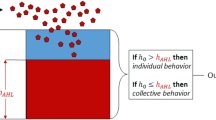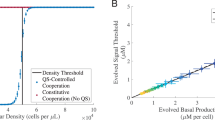Abstract
I describe how bacteria develop complex colonial patterns by utilizing intricate communication capabilities, such as quorum sensing, chemotactic signaling and exchange of genetic information (plasmids) Bacteria do not store genetically all the information required for generating the patterns for all possible environments. Instead, additional information is cooperatively generated as required for the colonial organization to proceed. Each bacterium is, by itself, a biotic autonomous system with its own internal cellular informatics capabilities (storage, processing and assessments of information). These afford the cell certain plasticity to select its response to biochemical messages it receives, including self-alteration and broadcasting messages to initiate alterations in other bacteria. Hence, new features can collectively emerge during self-organization from the intra-cellular level to the whole colony. Collectively bacteria store information, perform decision make decisions (e.g. to sporulate) and even learn from past experience (e.g. exposure to antibiotics)-features we begin to associate with bacterial social behavior and even rudimentary intelligence. I also take Schrdinger’s’ “feeding on negative entropy” criteria further and propose that, in addition organisms have to extract latent information embedded in the environment. By latent information we refer to the non-arbitrary spatio-temporal patterns of regularities and variations that characterize the environmental dynamics. In other words, bacteria must be able to sense the environment and perform internal information processing for thriving on latent information embedded in the complexity of their environment. I then propose that by acting together, bacteria can perform this most elementary cognitive function more efficiently as can be illustrated by their cooperative behavior.
Similar content being viewed by others
References
M. Dworkin, Microbiol. Rev. 60, 70 (1996)
E. Rosenberg Microbial ecology and infectious disease (ASM Press Washington, DC, 1999)
J.A. Shapiro, Bioessays 17, 597 (1995)
J.A. Shapiro, M. Dworkin, Bacteria as Multicellular Organisms (Oxford University Press, 1997)
J.A. Shapiro, Ann. Rev. Microbiology 52, 81 (1998)
E. Ben-Jacob, Ann. Rev. Microbiology 52, 779 (1998)
E. Ben-Jacob, I. Cohen, H. Levine, Adv. Phys. 49, 395 (2000)
E. Ben-Jacob, Phil. Trans. R. Soc. Lond. A 361, 1283 (2003)
E. Ben-Jacob et al. Trends. Microbiol. 12, 366 (2004)
H. Levine, E. Ben-Jacob, J. Physical Biology 1, 14 (2004)
E. Ben-Jacob, Y. Shapira, The Cradle of Creativity (in press)
E. Ben-Jacob, Y. Aharonov, Y. Shapira, J. Biofilm 1, 239 (2005)
E. Ben-Jacob, Y. Shapira, A.I. Tauber, Physica A 359, 495 (2006)
E. Ben-Jacob, H. Levine, J.R. Soc. Interface 3, 197 (2006)
E. Ben-Jacob et al., Physica A 282, 247 (2000)
I. Golding, E. Ben-Jacob, Coherent Structures in Complex Systems (Springer-Verlag, Heidelberg, 2001)
D.A. Kessler, J. Koplik, H. Levine, Adv. Phys. 37, 255 (1988)
J.S. Langer, Science 243, 1150 (1989)
E. Ben-Jacob, P. Garik, Nature 33, 523 (2000)
E. Ben-Jacob, Contemp. Phys. 34, 247 (1993)
P. Ball, The self-made tapestry-Pattern formation in nature (Oxford University Press, 1999)
L.P. Macfadyen, C. Ma, R.J. Redfield, J. Bacteriol. 180, 4401 (1998)
I. Bdejov et al., Science 30, 1404 (2003)
M. Ptashne, A. Gann, Nature 420, 211 (2002)
E.O. Budrene, H.C. Berg, Nature 349, 630 (1991)
Y. Blat, M. Eisenbach, J. Bacteriol. 177, 1683 (1995)
E.O. Budrene, H.C. Berg, Nature 376, 49 (1995)
E. Ben-Jacob et al., Nature 373, 566 (1995)
M.B. Miller, Cell 110, 303 (2002)
K.C. Mok, N.S. Wingreen, B.L. Bassler, EMBO J. 22, 870 (2003)
R. Wirth et al., Trends. Microbiol. 4, 96 (1996)
E. Ben-Jacob et al., Nature 368, 46 (2004)
Y. Kozlovsky, I. Cohen, I. Golding, E. Ben-Jacob, Phys. Rev. E 59, 7025 (1999)
E. Ben-Jacob et al. Modeling branching and chiral colonial patterning of lubrication bacteria, edited by P.V. Maini, H.G. Othmer (Springer, 2000)
A. Komoto, J. Theo, Biology 225, 91 (2003)
I. Cohen, I.G. Ron, E. Ben-Jacob, Physica A 286, 321 (2000)
I. Cohen, A. Czirok, E. Ben-Jacob, Physica A 233, 678 (1996)
A. Czirok et al., Phys. Rev. E 54, (1996)
C.J. Ingham, E. Ben-Jacob, Swarming and complex pattern formation in Paenibacillus vortex studied by imaging and tracking cells BMC Microbiology (in press)
J.A. Shapiro, Genetica 86, 99 (1992)
E. Ben-Jacob, Physica A 248, 57 (1998)
L. Kari, L.F. Landweber, Biocomputing in cilliates, in Cellular Computing, edited by M. Amos (Oxford University Press, 2003)
W. Makalowski, Science 300, 1246 (2003)
D.P. Bartel, Cell 116, 261 (2004)
D.H. Lenz, et al., Cell 118, 69 (2004)
R. Wesson, Beyond Natural Selection (The MIT Press, London, 1993)
Bacterial images and video clips are available from PhysicaPlus-the online magazine of the Israel Physical Society http://physicaplus.org.il and at Ben Jacob’s home page: http://star.tau.ac.il/~eshel/
Author information
Authors and Affiliations
Corresponding author
Rights and permissions
About this article
Cite this article
Ben-Jacob, E. Social behavior of bacteria: from physics to complex organization. Eur. Phys. J. B 65, 315–322 (2008). https://doi.org/10.1140/epjb/e2008-00222-x
Received:
Published:
Issue Date:
DOI: https://doi.org/10.1140/epjb/e2008-00222-x




